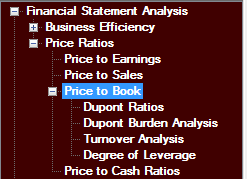5.9 Price to Book Ratio

Price/Book Ratio
is a measure of the
number of
years to recover the stock price with zero
growth in book value per share.
|
The book value per share
is a measure of the capital that shareholders have invested in
the company. It is
defined as the shareholder’s equity divided by the number of
shares outstanding.
An important bottom line driver of the price to book ratio is
the Return on Equity (ROE), which relates net income to
shareholder capital. In the next example we first examine this
relationship for a small set of firms.
In this example, the highest recent ROE is IBM and the
lowest is Target.
Example: Stocks Price/Book
Value versus ROE

A high Price/Book Ratio
implies that investors expect management to create more value
from the set of resources under their control.
In addition, a high Price/Book Ratio can also reflect
accounting measurement issues.
For example, you can see above that IBM is the highest
and Target is the lowest in the above sample.
This in part reflects the relative importance of labor in
terms generating revenue.
For the case of IBM it heavily relies upon highly skilled
human capital to provide solutions to IBM’s clients.
The retailers Wal-Mart and Target rely more heavily on
their product offerings in super and regular centers to generate
revenue. Further
because human capital is not capitalized under US GAAP the
relative importance of labor will be reflected in the Price to
Book ratio. The
table shows that there is a clear relationship between Price to
Book Value and ROE in at any point in time, a higher Price to
Book Value is associated with a higher ROE.
If you look at KO and PEP
in the table, for the TTM, the Price to Book Ratio is a little
higher for KO than it is for PEP (4.69 vs. 4.53.
In recent years, though, PEP has been higher than KO.
The current reversal could imply that the market is
expecting KO management to generate more value from the existing
set of assets than is the case for PEP, perhaps if the
acquisition of bottling plants leads to increased sales
resulting from the increased marketing flexibility and resulting
in a higher ROE.
